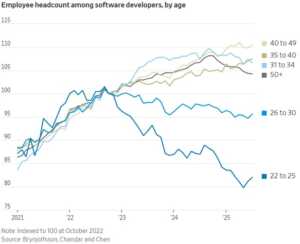There’s a palpable unease rippling through the corridors of tech, business, and academia. Generative AI—once a whisper of futuristic promise—has burst into our daily work lives, rewriting code, scripting memos, and tackling customer support. But beneath the fanfare lurks a nagging question: who’s paying the price?
Stanford researchers Erik Brynjolfsson, Bharat Chandar, and Ruyu Chen planted a flag in this shifting ground with their August 26, 2025, working paper, “Canaries in the Coal Mine? Six Facts about the Recent Employment Effects of Artificial Intelligence.” Drawing on nearly real-time, administrative payroll data from ADP—the U.S.’s largest payroll processor—they trace changes in employment patterns month by month, revealing a troubling trend: the youngest workers in AI-exposed jobs are rapidly being edged out.
Their metaphor is chillingly apt. Like the canary once used to detect deadly gas underground, early-career workers may be the first casualties of AI’s industrial march.
The Young Face the Storm: A 13% Drop in Entry-Level Jobs
 At the heart of the paper lies the first jarring fact: between late 2022 and mid-2025, employment for 22–25-year-olds in the most AI-exposed occupations—jobs like junior software developers and customer service representatives—dropped by a stark 13%, even when accounting for firm-specific shocks.
At the heart of the paper lies the first jarring fact: between late 2022 and mid-2025, employment for 22–25-year-olds in the most AI-exposed occupations—jobs like junior software developers and customer service representatives—dropped by a stark 13%, even when accounting for firm-specific shocks.
Imagine starting your career, brimming with ambition, only to find opportunities vanish. It’s not just disruption—it’s dislocation.
Don’t Paint with a Broad Brush: Older and Less-Exposed Workers Stay Resilient
But this isn’t a sweeping collapse of the job market. In fact, older workers in the same AI-exposed roles held steady—or even grew in numbers. Meanwhile, entry-level employment in jobs far less exposed to AI saw patterns of stability or growth among the youngest cohort.
In these scenarios, it’s not that youth is failing—it’s that automation is selectively targeting the greenhorns.
Automation vs. Augmentation: A Fork in the Road
Not all AI is equal in its workplace impact. The researchers highlight a compelling divide: occupations where AI predominantly automates tasks exhibit the most severe entry-level job losses. But in roles where AI acts as a tool to augment human effort, job falls are either absent or marginal.
This sharper clarity should galvanize organizations: choose augmentation over automation if you’re intent on nurturing—and keeping—your junior staff.
The Decline Is Headcount, Not Pay
That means entry-level hiring freezes, not wage depression. It’s a structural shift, not just belt-tightening.
Ruling Out Alternative Explanations: This Isn’t Remote Work or Tech-Cycle 2.0
Could this trend be driven instead by remote work, COVID hangovers, or cyclical industry shifts? The researchers tested for those, too. They reran their analysis excluding tech firms, remote-amenable roles, and more, and the core findings held firm.
This isn’t just aftershock from the pandemic or Silicon Valley’s booms and busts—it’s something new.
Youth as Early Indicators: The Canaries in the Coal Mine
Putting it all together: entry-level workers in AI-vulnerable roles are bearing the brunt of its labor-market disruption. They’re the canaries, the early warning system. When AI shifts from the lab to strategic deployment, the first tremors come in the form of fewer junior hires.
One Reddit commenter captured it elegantly:
“There’s a clear, evident change when you specifically look at young workers who are highly exposed to AI.”
Critiques & Limitations
- The ADP dataset may skew toward faster-growing firms in specific regions.
- It excludes 30% of workers who lack fully recorded job titles.
- Most critically, it doesn’t account for immigration effects, potentially omitting a big piece of what’s affecting entry-level hiring.
The authors themselves acknowledge these limitations and call for future triangulation using alternate sources like the American Community Survey (ACS).
Why This Matters—and Who Should Listen
- Job Seekers & Graduates: If you’re within your early 20s eyeing AI-exposed fields, know that opportunities are narrowing—such jobs are being automated before your career can begin.
- Policymakers & Educators: It’s time to double down on early-career support, upskilling pathways, and curriculum pivots—especially in regions and roles ripe for automation.
- Employers & Industry Leaders: The data underscores a choice: pursue AI that augments and uplifts, or risk hollowing out your talent pipeline. How you deploy automation now may determine whether you’ll have tomorrow’s skilled workforce.
Drama in the Data: A Closing Scene
Picture a bustling tech office in early 2023: desks stacked with new graduate resumes, the energy of first jobs crackling in the air. Flash forward to mid-2025. The AI assistants are humming—but the desks are emptier. Where dozens once joined as eager junior developers or support reps, now only a few seniors remain, and the silence lingers.
This isn’t dystopia. It’s the real-time fallout of progress. The paper warns us that as AI spreads, not everyone reaps its gifts equally—and it’s the young who feel its edge first.
Final Thoughts: A Call to Conscious AI Deployment
The metaphor of the canary serves not to doom us, but to alert us: there’s still time to choose a different path. AI can drive productivity, spark collaboration, and create new roles—if it’s wielded judiciously.
This study is a wake-up call. Entry-level talent is a fragile, invaluable resource. Let’s not let it become collateral in our race toward automation.

